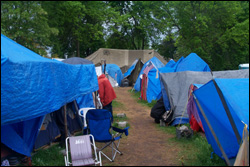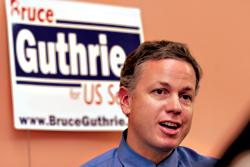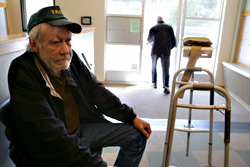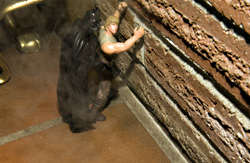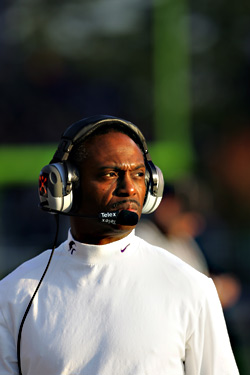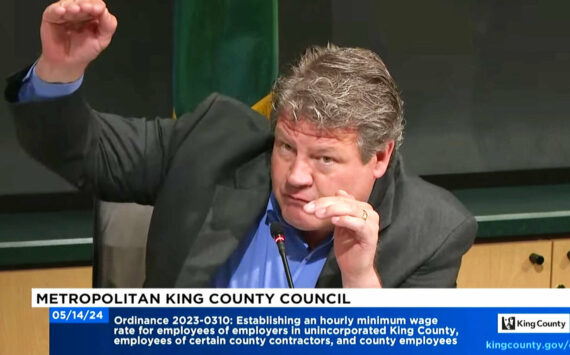When you see the 77 tents—some brand new, some relics of the Vietnam era—spread across a small field in a Lake City neighborhood, you wonder what the furor is about. This is Tent City 3, the roving homeless shelter that’s shuttled about Seattle since 1999 without fanfare or trouble, and the furor is the reaction last week by Eastside residents to plans, made with the blessing of King County Executive Ron Sims, to create Tent City 4 on vacant county land near Bothell. Eastsiders have sued the county over the camp. Most dramatically, many of them gave vent to their spleen on local television at a community meeting on May 3. Grown men shouted at children and senior citizens. “Shut up, you old hag!” was how one Eastside homeowner put it to a woman trying to speak in favor of the homeless.
Ugly is what that was. Ugly, too, have been the phone calls to Sims’ office, described by county officials as some of the angriest they’ve ever encountered. Some of the calls threatened violence, according to Elaine Kraft, a spokesperson for Sims. You’d think the feds were dropping nuclear waste into a pristine Eastside neighborhood.
The reaction on the Eastside is largely a function of people with limited exposure to the urban world letting stereotypes of the homeless obliterate their ability to reason. “Everywhere we go, it’s always the same thing,” says Leo Rhodes, a camp spokesperson. “People see drunks and druggies on the streets, and they think those are the homeless. We are trying to break that stereotype.”
The idea is simple. There are an estimated 2,000-plus homeless on the streets each night, once all the county’s shelter beds are filled. It’s been this way for the past decade as America has come to tacitly accept homelessness as a normal by-product of American life. In the early 1990s, a group known as SHARE/WHEEL, run by the homeless, organized to fight back. It was safer for the homeless to live together in a community of their own than going it alone on the streets, and it made a hell of a political statement.
After officials razed two encampments in the 1990s, Tent City 3 came to life in 1999, temporarily sited at various houses of worship around Seattle, smack dab in residential neighborhoods in most cases. There have been few problems. The camp moves every 90 days, and some neighborhoods have welcomed it for return visits.
“They are very well behaved,” says Scott Lee, whose home abuts Tent City 3 on Northeast 125th Street, next to Lake City Christian Church. “They’re not noisy and they are not disrespectful.” Tent City 3 is slated to split into two camps on May 17. One camp will move to the Eastside, becoming Tent City 4, and the other, Tent City 3, will move to church property in Seattle’s Central District.
The homeless who live at Tent City do not fulfill most stereotypes of the homeless. For one, each of them with whom I spoke was clean. Some residents take a bus to Green Lake Park each day and use the showers; others use facilities at shelters downtown. Their clothes are not dirty or ripped. You could take the Tent City crowd and drop them into Bellevue Square and, lack of prosperity aside, they wouldn’t look out of place.
The tents are screened from most neighbors by blue plastic. To the south sit two immense new homes, their backyards facing latter-day Hooverville. Even on a drizzly afternoon, the site is well drained and hardly muddy. There is no stray trash. There are four portable toilets, and there are dumpsters, too. A cooking tent, where the only heat source is a small microwave oven, sits near the camp’s entrance. On folding tables are baskets of fruit and sandwiches and pastries, donated by various groups around town. Residents gather under a nearby awning and smoke and talk, in a quasi–community center.
The camp has its own security detail. If you fight or drink or do drugs here, you get kicked out. Law-enforcement officials, including Seattle police, report no problems with the camp and say that it hasn’t led to an increase in crime near any of its many sites over the past four years.
These are not your hardened, chronic street people who berate passersby for money downtown or outside the local QFC. Many whom I spoke with at the camp work sporadically at temporary jobs, doing construction work or landscaping. They are situationally homeless, which is to say they don’t make enough money to rent a room, much less an apartment. Several of them said they’ve given up on finding low-income housing through government programs, due to waiting lists that run as long as 18 months.
In other words, these are people who are actively taking responsibility for their situation. Tent City’s track record is good enough that it’s been at the Lake City site twice with nary a protest from area homeowners. It’s been a similar experience in the Central District.
You don’t hear anyone in the Central District shouting at children and their elders about that. But let a couple of dozen homeless—the Bothell site will initially house 20 to 30 people—plan to move to the Eastside, and all hell breaks loose, out of all proportion to what the camp is and how its residents have performed on this side of Lake Washington.
